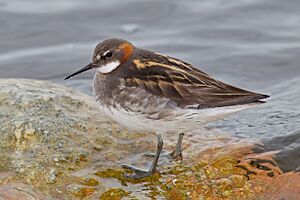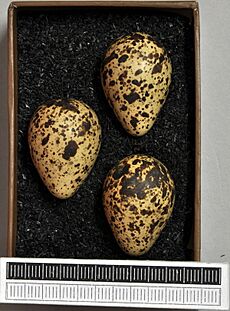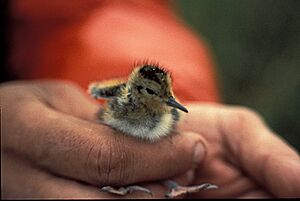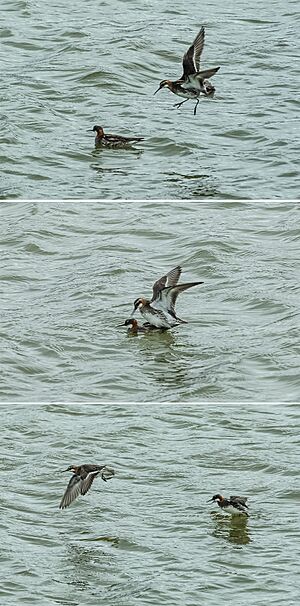Red-necked phalarope facts for kids
Quick facts for kids Red-necked phalarope |
|
|---|---|
 |
|
| Breeding plumage | |
 |
|
| Winter plumage | |
| Conservation status | |
| Scientific classification | |
 |
|
| Range of P. lobatus Breeding range Wintering range | |
| Synonyms | |
|
The red-necked phalarope (Phalaropus lobatus) is a small wader bird. It is also known as the northern phalarope. These birds breed in the cold Arctic regions of North America and Eurasia.
Red-necked phalaropes are migratory. This means they travel long distances. Unlike most waders, they spend their winters far out at sea in warm, tropical oceans.
Contents
About the Red-necked Phalarope's Name
The scientific name for this bird is Phalaropus lobatus. The name Phalaropus comes from old Greek words. These words mean "coot" and "foot". Both coots and phalaropes have special lobed toes.
The word lobatus in its scientific name means "lobed" in Latin. This refers to their unique lobed toes. These toes help them swim well.
What Does the Red-necked Phalarope Look Like?
The red-necked phalarope is about 18 cm (7.1 in) long. It has a thin, straight bill. Its toes are lobed, which helps it swim easily.
When breeding, the female bird is mostly dark grey on top. She has a chestnut-colored neck and upper chest. Her face is black, and her throat is white. She also has a white stripe on her wing. This stripe helps tell her apart from the similar Wilson's phalarope.
The male bird in breeding season looks a bit duller than the female. Young phalaropes are grey and brown on top. Their undersides are buff, and they have a black patch around their eye. In winter, their feathers are mostly grey on top and white underneath. The black eye patch stays visible.
These birds make a sharp call. It sounds like a whit or twit.
| Total Body Length | 170–200 mm (6.5–8 in) |
| Weight | 35 g (1.2 oz) |
| Wingspan | 380 mm (15 in) |
Red-necked Phalarope Behavior and Life Cycle
Reproduction and Family Life
In red-necked phalaropes, the females are usually larger and brighter than the males. Females will chase and even fight over males. They protect their chosen mate from other females. This continues until the female lays her eggs.
The male phalarope does all the work of incubating the eggs. He also takes care of the chicks after they hatch. Females might try to find another mate after laying their first clutch of eggs. If a male's eggs are eaten by predators, he might try to breed again. He could pair with his first mate or a new female.
Once it's too late in the season to start new nests, the females begin their journey south. They leave the males to raise the young birds.
The nest is a small dip in the ground. It is lined with grass and often built on a small mound. A female usually lays four olive-buff eggs with spots. The eggs hatch in about 20 days.
The young birds mostly find their own food. They can fly within 20 days of hatching.
How They Find Food
When a red-necked phalarope is feeding, it often swims in fast, small circles. This creates a tiny whirlpool in the water. This behavior helps bring food up from the bottom of shallow water.
The bird then reaches its bill into the center of the swirling water. It picks out small insects or crustaceans that are caught in the current. In the open ocean, they often gather where ocean currents meet. These spots have lots of food brought up from deeper water.
During their long migrations, some groups stop in places like the Bay of Fundy. They use the strong tidal currents there to stir up food.
Migration and Temperament
Red-necked phalaropes spend almost all their non-breeding time in the open ocean. They do not often come into contact with people. Because of this, they can be very tame.
Where Do They Live in Britain and Ireland?
The red-necked phalarope is a rare bird that breeds in Ireland and Britain. These areas are at the very edge of their global range.
The best place to see them is in Shetland, especially at the Loch of Funzie on Fetlar. A few birds also breed in other parts of Scotland. These include the Outer Hebrides and sometimes the Scottish Mainland.
They have also bred in western Ireland since around 1900. The population there grew to about 50 pairs at one point. However, there have been very few breeding records in Ireland since the 1970s. In 2015, breeding was reported in County Mayo.
Scientists have tracked a bird from Fetlar using a tag. They found it spent winter with a North American group in the tropical Pacific Ocean. This bird made a huge 16,000 mi (26,000 km) round trip. It flew across the Atlantic, then south along the American coast. It crossed the Caribbean and Mexico. Finally, it ended up off the coast of Ecuador and Peru. This suggests that the Shetland birds might be related to North American birds.
Images for kids











